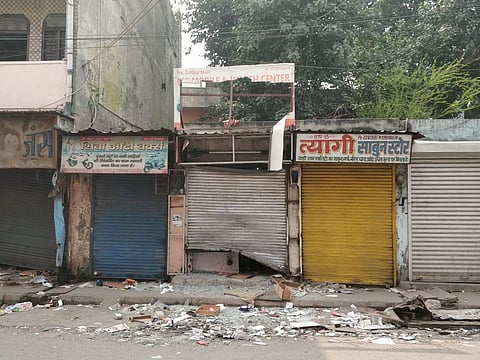

NEW DELHI: The riots in north east Delhi in February this year was the "worst communal riots since partition" in the national capital and that it was a "gaping wound" in the conscience of a nation aspiring to be a "major global power," observed a Delhi Court on Thursday.
The remarks by the court came while dismissing the bail pleas in three cases of former AAP Councillor Tahir Hussain, who allegedly abused his "muscle power" and "political clout" to foment communal violence.
"It is common knowledge that the dreary day of February 24, 2020 saw parts of north-east Delhi gripped by a communal frenzy, reminiscent of carnage during the days of partition."
Soon, the riots spread like wildfire across the smoke-grey skyline of Capital, engulfing new areas and snuffing out more and more innocent lives.
The Delhi riots 2020 are a gaping wound in the conscience of a nation aspiring to be a major global power.
"Even if there were no direct acts of violence attributable to the applicant, he cannot shy away from his liability under the provisions of the sections invoked against him, particularly on account of the fact that his house/building became the hub/centre point for the rioters and rabble-rousers to unleash the worst communal riots since partition in Delhi," Additional Sessions Judge Vinod Yadav said.
The court further said the spread of riots on such a big scale in such a short time is not possible without a "premeditated conspiracy".
At this stage, I am reminded of a famous English saying which says that 'when you choose to play with embers, you cannot blame the wind to have carried the spark a bit too far and spread the fire'.
"So, when the applicant (Hussain) is at the receiving end now, he cannot pass on the buck by simply taking a plea that since he did not participate physically in the riots, so he has no role to play in the riots. It is prima facie apparent that the applicant abused his muscle power and political clout to foment communal violence in the area," the judge said.
One of the cases pertained to the alleged presence of 100 people standing on the terrace of Hussain's house with petrol bombs and throwing them on the persons belonging to another community during the riots in Dayalpur area.
The second case related to looting of a shop in the area due to which the shop's owner incurred a loss of about Rs 20 lakh.
The third case related to looting and torching of a shop due to which the owner incurred a loss of around Rs 17-18 lakh.
The judge said there was enough material on record to presume that Hussain was very well present at the spot of crime and exhorting the rioters of a particular community and as such, he did not use his hands and fists, but rioters as "human weapons", who on his instigation could have killed anybody.
"It is noteworthy that at the time of eruption of communal riots in the area(s) of north-east Delhi, the applicant (Hussain) has been in a powerful position (being sitting Councillor of the area from Aam Aadmi Party) and it is prima facie apparent that he used his muscle power and political clout to act as a kingpin in planning, instigating and fanning the flames of communal conflagration," the court said in its order.
It further said that the allegations against Hussain were grave in nature.
Regarding the contention raised by Hussain's counsel that there was a delay in recording of statements of the witnesses in the cases, the court said it can be said to be delayed when the witnesses were known to the police and yet police do not record their statements; whereas, in a case of rioting, police hardly has any idea as to who were the witnesses.
"Further, people normally do not come forward and it is admitted position on record that on the date of incident nearly 10,000 PCR (police control room) calls were recorded in the area of PS (police station) Dayalpur. Thereafter, on the basis of these calls, police reverted back and traced out some of the witnesses. Therefore, at this stage, it cannot be said that there is delay in recording of statements of witnesses by investigating agency," it added.
It said that the public witnesses in the three matters were residents of the same locality and if released on bail at this stage, the possibility of Hussain threatening or intimidating them cannot be ruled out.
It added that though there was no video footage or CCTV footage, showing Hussain's presence at the spot, there was enough ocular evidence available on record.
The independent public witnesses in the matters have categorically identified him to be present at the scene of crimes on the date of incidents, said the court.
"It is nowhere disputed that the applicant (Hussain) is a public figure and the public witnesses are residents of the same locality, so prima facie this Court has to believe that the aforesaid public witnesses knew the applicant very well" I find the "ocular evidence" of independent witnesses to be categorical, which gives the clear details qua the active role played by him in the incidents in question," it said.
The court further said that the call detail record analysis confirmed his presence at or around the scene of the crimes on the date of the incident.
Senior advocate K K Manan, appearing for Hussain, claimed that he has been falsely implicated in the matter by the police and his political rivals with the sole purpose of harassing him by abuse of the machinery of law.
Special Public Prosecutor Manoj Chaudhary said Hussain was the main kingpin/conspirator in the cases.